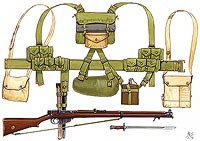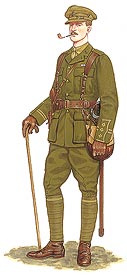The First World War 1914-1918
The East Surrey Regiment

 |
| Mills web equipment,1908 with 'PH' Gas Helmet bag on the left and the Small Box respirator case on the right; Short Magazine Lee Enfield Rifle Number 1, Mark III, 1907 with sword bayonet. |
The East Surrey Regiment also contributed greatly to the First World War. Eighteen battalions were formed, 6000 men were lost and seven Victoria Crosses (VCs) won. Their experiences were similar to The Queen’s; initially, the old Regular Army deployed, followed by the Reservists and Territorials. The ranks were later filled, again, by the “New Army” of Volunteers and then finally, nearer the end of the War, by the Conscripts.
The Regular Battalions
The 1st Battalion The East Surreys joined the 14th Brigade of
the 5th Division of the British Expeditionary Force and, during
the first few months of the War gained honours at Mons, Le Cateau,
on the Marne and on the Aisne. In the Spring it probably achieved
its finest feat of the war in the Defence of Hill 60 near Ypres
on 23rd April 1915. During this action, the Battalion gained three
VCs, two Military Crosses (MCs) and seven Distinguished Conduct
Medals (DCMs). On 10th April 1915, the 1st and 2nd Battalions
met for the first time since the old 31st Foot and 70th Foot had
met on active service during the 18th Century French Revolutionary
Wars. The 1st Battalion served in France during the entire War
except for a short tour in Italy from 1917 to Spring 1918. Following
the Armistice, it went to Russia, operating along the Murmansk
railway.
 |
| Officer of the East Surreys, Service Dress 1916 with trench cap. |
The 2nd Battalion, part of the 85th Brigade of the 28th Division, was heavily engaged in the Ypres sector almost immediately after being moved up the line for the first time in January 1915. A and C Companies were almost annihilated and shortly after, C and D Companies suffered almost as badly. After only five days of fighting barely 200 men remained of the 1000, who had disembarked in France such a short time before. The Battalion was reinforced and fought at Loos and the Hohenzollern Redoubt and in September won its VC. In October 1917, the 28th Division was withdrawn and was sent to Macedonia and then on to Salonika. In 1918, the Battalion was heavily engaged in the attack near Lake Doiran.
The Territorial Force Battalions
The 1/5th Battalion spent most of the War in India, but was part
of the Force which, in 1917, forced the Turks to surrender in
Mesopotamia. The 1/6th also served in India, then in the Aden
Protectorate, where it was engaged against roving Turkish guerilla
bands.
The Service Battalions
Seven Service battalions were raised as part of Kitchener’s
Army. The 10th and 11th were used for auxiliary purposes and recruiting,
but the 7th, 8th, 9th, 12th and 13th went to France. The 7th and
8th fought at Loos, but the remainder joined the 1st on the Somme.
On the 1st July 1916, B Company, 8th Surreys of the 18th Division
gained immortality, when they had the effrontery to dribble four
footballs across No Man’s Land during the attack on Montauban.
They lost 446 men killed, wounded or taken prisoner that day,
though the battalion won two DSOs, two MCs, two DCMs and nine
Military medals (MMs); in addition, their objectives were secured.
The same Battalion fought at Passchendaele and the Third Battle
of Ypres. The 7th Battalion went on to fight on the Somme, at
Albert and Arras and won its VC. The 12th Battalion fought with
distinction at Ploegsteert Wood, on the Somme, at Messines and
took part in Third Battle of Ypres. It then went on to Italy,
where it remained for four months until returning to the Western
Front. The 13th Battalion arrived in France to fight on the Somme
and at Cambrai and Arras. It won its VC at Villers Plouich and
the 9th Battalion gained a further VC at Lens in 1918.
